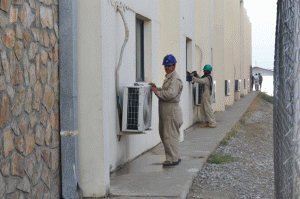SIGAR Reports That Afghan Bases Can’t Be Maintained After Handoff

SIGAR found a team of Afghan technicians being trained to maintain heating and air conditioning units in Kabul in October, 2011.
The Special Inspector General for Afghanistan Reconstruction (SIGAR) released its quarterly report (pdf) this week. Along with the report, it issued an audit (pdf) with the long title “Afghan National Security Forces Facilities: Concerns With Funding, Oversight, and Sustainability for Operation and Maintenance”. What SIGAR has found is that the massive investment that we have made in building military bases and training facilities is likely to be wasted because Afghanistan will be incapable of maintaining those bases after they have been handed over into Afghan control.
The audit report provides some context for the investigation:
A key objective of coalition efforts in Afghanistan is to build the country’s capacity to provide for its own security by training and equipping the Afghan National Security Forces (ANSF), which consist of the Afghan National Army (ANA) and the Afghan National Police (ANP). Between fiscal years 2002 and 2012, the U.S. Congress appropriated $52.15 billion to equip, train, base, and sustain the ANSF. Approximately $11.7 billion of this amount has been appropriated for the construction of ANSF facilities. In our prior audits of U.S.-funded ANSF construction projects, we expressed concerns about the Afghan government’s ability to sustain these facilities in the absence of U.S. and coalition support, thus risking that U.S. investment will not be sustained after an expected significant decrease in international support after 2014.
In February 2011, the North Atlantic Treaty Organization Training Mission-Afghanistan (NTM-A) developed a plan to transition operation and maintenance (O&M) of ANSF facilities to the Afghan government by the end of 2014. In an effort to ensure that facilities are maintained until the ANSF is capable of doing so, NTM-A obligated $800 million to fund these services for Afghan army and police facilities across Afghanistan. In July 2010, the U.S. Army Corps of Engineers (USACE) awarded two firm-fixed-price contracts to ITT Exelis Systems Corporation (Exelis) to provide O&M for facilities in northern and southern Afghanistan. The contract covering facilities in the northern provinces is valued at $450 million and the contract covering the southern provinces at $350 million. The services include the O&M of buildings, structures, and utility systems and pest control. The contracts also require Exelis to train ANSF workers on the trade skills required for O&M.
What SIGAR is telling us is that we have invested over $50 billion since 2002 in the training fiasco and that a bit over 20% of that money, or just under $12 billion, has been spent in the construction of facilities for the Afghan security forces to use. It never occurred to the geniuses at NATO that our forces would leave some day and put the Afghans in charge of $12 billion worth of facilities, and so it wasn’t until the middle of 2010 that any steps were taken to prepare the Afghans to maintain the facilities.
Of course, our outsourcing mentality long ago stripped the military of its own operations and maintenance capabilities, so we had to outsource even the training for operations and maintenance. It should come as little surprise then, that this effort is an abject failure: Read more →
